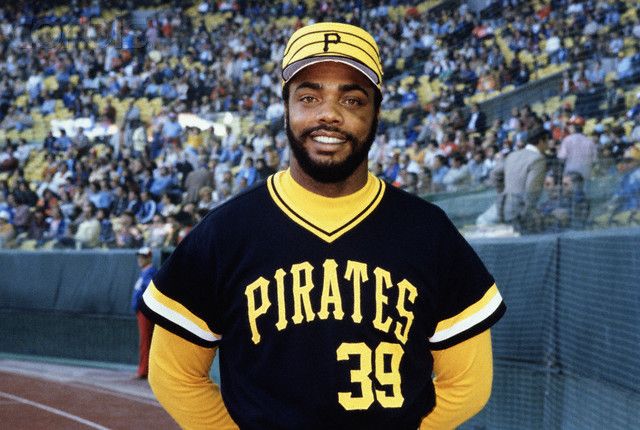In 1975, Dave Parker played full-time for the first time in the majors and he wound up finishing third in the National League Most Valuable Player voting. Two years later, he made his first All-Star appearance, won his first Gold Glove, and once again he finished third in the MVP voting. Those two seasons will eventually be covered here in the Pittsburgh Pirates Seasons feature. However, we introduce Parker here for the first time with the 1978 season, when he walked away with the NL MVP award.
Parker won the NL batting title in 1977 with a .338 average. He collected 215 hits and 44 doubles, both of which led the league. About the only thing he didn’t do well that year was steal bases. He went 17-for-36 on the season. It was a great overall season and there were high expectations for Parker for 1978. He did not disappoint.
The season began on April 7th and Parker had a slow first week, posting a .556 OPS. By the end of April, he had a 1.022 OPS in 19 games. He had a 13-game hitting streak from April 14th until April 30th, with seven multi-hit games.
That hitting streak was snapped on May 1st and the month was a rough one for Parker. He did not look like an MVP, hitting .225/.283/.360 in 28 games. Through his first 47 games, he had a .795 OPS.
It felt like a light switch was flipped just as the calendar switched to June. Parker had hits in the first seven games of the month, with six multi-hit contests. After one hitless game, he started another seven-game hit streak. One 0-for-5 day on June 23rd was followed immediately by an eight-game hit streak to end the month. In 24 games, Parker batted .392/.464/.670, with six doubles, three triples, five homers, 18 runs scored and 18 RBIs.
The slow May could have prevented Parker from getting his second straight All-Star game selection, but it didn’t help that on June 30th, a home plate collision left Parker with a fractured cheekbone. He didn’t play again until after the All-Star break, coming back to action with a protective mask to bat and a football style face shield on the bases.

Parker had a tough time hitting with the face mask on when he first came back. In his first 14 games, he batted .148/.164/.370, with one walk and 14 strikeouts. Between his slow May, July slump and 11 missed games with an injury, this doesn’t feel like we are describing an MVP season here.
Because of the strong April and June performances, Parker still had an .844 OPS after an August 6th doubleheader. From that point until the end of the season, he earned and secured that MVP crown.
It all began with three hits on August 7th. That was followed by a 5-for-5 game in which he homered and drove in three runs. It was the first of three times that he collected five hits in a game during his career. He homered in four of the next six games, then on August 16th he hit two homers, walked twice, and drove in five runs. Parker had three hits on the 18th, four hits on the 23rd, and finished the month with four multi-hit games in the last five days. From August 7th until the end of the month, Parker batted .412/.467/.753 in 24 games.
His hitting didn’t let up at all to start September. He had seven hits in his first three games. Parker had a .313 average after play on September 9th. He had three hits the next day, then hit two homers and drove in four runs on the 12th, but five days later, his average was just one point higher. The last 15 games of the season was his best stretch of the year.
Parker hit .518/.585/.964 in his last 65 plate appearances. He drove in 17 runs and scored 16 runs in those 15 games. He had two games with four RBIs, one game with two homers and 11 games with two or more hits. By the time the season ended, he had won his second straight batting title. Parker finished with a .334/.394/.585 slash line, with 32 doubles, 12 triples, 30 homers, 117 RBIs, 102 runs scored and 20 stolen bases in 27 attempts.
His 7.0 WAR that season is the 34th highest in a season for a position player on the Pirates. His .585 slugging ranks 14th highest among Pirates for a single season, and his .979 OPS in 19th best. His best mark that season was the 340 total bases, which is tied for sixth best in team history, and that’s despite the fact that he missed 11 games to begin July. This was also one of just 33 seasons in which a player hit 30+ homers for the Pirates. The RBI total has him tied for 19th best. As for the more advanced stats, his Adjusted OPS+ of 166 is tied for the 24th best in team history with Andrew McCutchen’s 2014 season.
Parker won the Gold Glove again in 1978 and he was named the MVP on November 16th. He received 21 of 24 first place votes, with shortstop Larry Bowa of the Philadelphia Phillies collecting the other three votes. Parker had the second highest WAR that year, trailing only (by a wide margin) Atlanta pitcher and future Hall of Famer Phil Niekro. As an interesting side note, Niekro nearly doubled the nearest competitor in pitching WAR, yet he finished sixth in the Cy Young voting. Parker won the Pirates fourth MVP award, following Paul Waner (1927, see below), Roberto Clemente (1966) and Dick Groat (1960).
This was Parker’s best career season on offense according to WAR, though his defense pushed the year below his 1977 season (7.4 WAR). He set career bests with triples, stolen bases, slugging percentage and OPS, as well as OPS+.
Here are the previous articles in this series:



